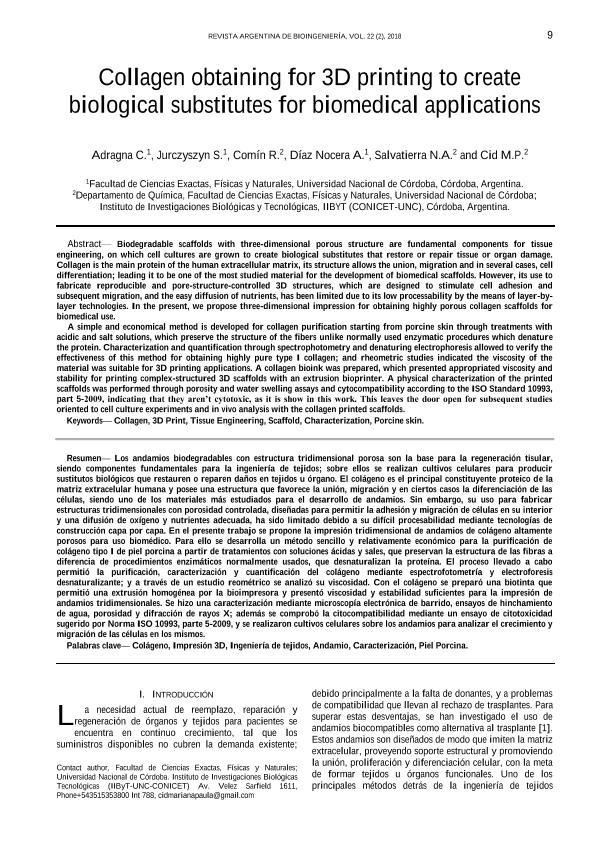Artículo
Los andamios biodegradables con estructura tridimensional porosa son la base para la regeneración tisular, siendo componentes fundamentales para la ingeniería de tejidos; sobre ellos se realizan cultivos celulares para producir sustitutos biológicos que restauren o reparen daños en tejidos u órgano. El colágeno es el principal constituyente proteico de la matriz extracelular humana y posee una estructura que favorece la unión, migración y en ciertos casos la diferenciación de las células, siendo uno de los materiales más estudiados para el desarrollo de andamios. Sin embargo, su uso para fabricar estructuras tridimensionales con porosidad controlada, diseñadas para permitir la adhesión y migración de células en su interior y una difusión de oxígeno y nutrientes adecuada, ha sido limitado debido a su difícil procesabilidad mediante tecnologías de construcción capa por capa. En el presente trabajo se propone la impresión tridimensional de andamios de colágeno altamente porosos para uso biomédico. Para ello se desarrolla un método sencillo y relativamente económico para la purificación de colágeno tipo I de piel porcina a partir de tratamientos con soluciones ácidas y sales, que preservan la estructura de las fibras a diferencia de procedimientos enzimáticos normalmente usados, que desnaturalizan la proteína. El proceso llevado a cabo permitió la purificación, caracterización y cuantificación del colágeno mediante espectrofotometría y electroforesis desnaturalizante; y a través de un estudio reométrico se analizó su viscosidad. Con el colágeno se preparó una biotinta que permitió una extrusión homogénea por la bioimpresora y presentó viscosidad y estabilidad suficientes para la impresión de andamios tridimensionales. Se hizo una caracterización mediante microscopía electrónica de barrido, ensayos de hinchamiento de agua, porosidad y difracción de rayos X; además se comprobó la citocompatibilidad mediante un ensayo de citotoxicidad sugerido por Norma ISO 10993, parte 5-2009, y se realizaron cultivos celulares sobre los andamios para analizar el crecimiento y migración de las células en los mismos. Biodegradable scaffolds with three-dimensional porous structure are fundamental components for tissue engineering, on which cell cultures are grown to create biological substitutes that restore or repair tissue or organ damage. Collagen is the main protein of the human extracellular matrix, its structure allows the union, migration and in several cases, cell differentiation; leading it to be one of the most studied material for the development of biomedical scaffolds. However, its use to fabricate reproducible and pore-structure-controlled 3D structures, which are designed to stimulate cell adhesion and subsequent migration, and the easy diffusion of nutrients, has been limited due to its low processability by the means of layer-bylayer technologies. In the present, we propose three-dimensional impression for obtaining highly porous collagen scaffolds for biomedical use. A simple and economical method is developed for collagen purification starting from porcine skin through treatments with acidic and salt solutions, which preserve the structure of the fibers unlike normally used enzymatic procedures which denature the protein. Characterization and quantification through spectrophotometry and denaturing electrophoresis allowed to verify the effectiveness of this method for obtaining highly pure type I collagen; and rheometric studies indicated the viscosity of the material was suitable for 3D printing applications. A collagen bioink was prepared, which presented appropriated viscosity and stability for printing complex-structured 3D scaffolds with an extrusion bioprinter. A physical characterization of the printed scaffolds was performed through porosity and water swelling assays and cytocompatibility according to the ISO Standard 10993, part 5-2009, indicating that they aren’t cytotoxic, as it is show in this work. This leaves the door open for subsequent studies oriented to cell culture experiments and in vivo analysis with the collagen printed scaffolds.
Collagen obtaining for 3D printing to create biological substitutes for biomedical applications
Adragna, Celeste; Jurczyszyn, Santiago; Comin, Romina ; Díaz Nocera, Adén; Salvatierra, Nancy Alicia
; Díaz Nocera, Adén; Salvatierra, Nancy Alicia ; Cid, Mariana Paula
; Cid, Mariana Paula
 ; Díaz Nocera, Adén; Salvatierra, Nancy Alicia
; Díaz Nocera, Adén; Salvatierra, Nancy Alicia ; Cid, Mariana Paula
; Cid, Mariana Paula
Fecha de publicación:
21/06/2018
Editorial:
Sociedad Argentina de Bioingeniería
Revista:
Revista Argentina de Bioingenieria
e-ISSN:
2591-376X
Idioma:
Español
Tipo de recurso:
Artículo publicado
Clasificación temática:
Resumen
Archivos asociados
Licencia
Identificadores
Colecciones
Articulos(IIBYT)
Articulos de INSTITUTO DE INVESTIGACIONES BIOLOGICAS Y TECNOLOGICAS
Articulos de INSTITUTO DE INVESTIGACIONES BIOLOGICAS Y TECNOLOGICAS
Citación
Adragna, Celeste; Jurczyszyn, Santiago; Comin, Romina; Díaz Nocera, Adén; Salvatierra, Nancy Alicia; et al.; Collagen obtaining for 3D printing to create biological substitutes for biomedical applications; Sociedad Argentina de Bioingeniería; Revista Argentina de Bioingenieria; 22; 2; 21-6-2018; 9-17
Compartir



